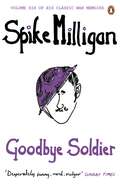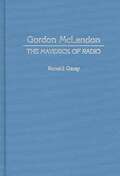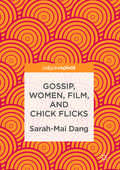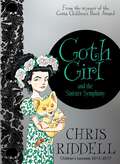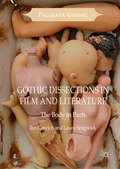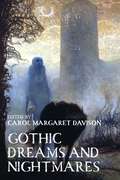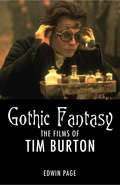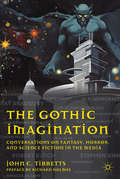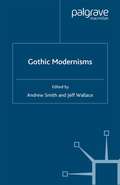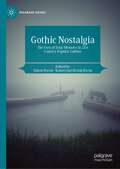- Table View
- List View
Goodbye Soldier: A Biography (Spike Milligan War Memoirs #6)
by Spike MilliganSpike Milligan's legendary war memoirs are a hilarious and subversive first-hand account of the Second World War, as well as a fascinating portrait of the formative years of this towering comic genius, most famous as writer and star of The Goon Show. They have sold over 4.5 million copies since they first appeared.'The most irreverent, hilarious book about the war that I have ever read' Sunday Express'Brilliant verbal pyrotechnics, throwaway lines and marvelous anecdotes' Daily Mail'Desperately funny, vivid, vulgar' Sunday Times'My namer is Maria Antonoinetta Fontana, but everyone call me Toni.' 'I'm Spike, sometimes known as stop thief or hey you.' 'Yeser, I know.' The sixth volume of Spike Milligan's off-the-wall account of his part in World War Two sees our hero doing very little soldiering. Because it's 1946. Rather, he is now part of the Bill Hall Trio - a 'Combined Services Entertainment' inflicted on unsuspecting soldiers across Italy and Austria - and is largely preoccupied with the unbearably beautiful ballerina, Ms Toni Fontana ('Arghhhhhhhhh!). But he must enjoy it while he can before he is demobbed and sent home to Catford - so he does ...'That absolutely glorious way of looking at things differently. A great man' Stephen Fry'Milligan is the Great God to all of us' John Cleese'The Godfather of Alternative Comedy' Eddie Izzard'Manifestly a genius, a comic surrealist genius and had no equal' Terry Wogan'A totally original comedy writer' Michael Palin'Close in stature to Lewis Carroll and Edward Lear in his command of the profound art of nonsense' GuardianSpike Milligan was one of the greatest and most influential comedians of the twentieth century. Born in India in 1918, he served in the Royal Artillery during WWII in North Africa and Italy. At the end of the war, he forged a career as a jazz musician, sketch-show writer and performer, before joining forces with Peter Sellers and Harry Secombe to form the legendary Goon Show. Until his death in 2002, he had success as on stage and screen and as the author of over eighty books of fiction, memoir, poetry, plays, cartoons and children's stories.
Goosebumps: Revenge of the Lawn Gnomes (PDF)
by R. L. StineKEEP OFF THEIR GRASS!Two pink flamingos. A whole family of plaster skunks. Joe Burton's dad loves tacky lawn ornaments. But when he brings home two ugly lawn gnomes, the trouble begins. Late at night. When everyone's sleeping. Someone's creeping in the garden. Whispering nasty things. Smashing melons. Squashing tomatoes. No way two dumb old lawn ornaments with pointy hats could be causing all the trouble... Is there?
Gordon McLendon: The Maverick of Radio (Contributions to the Study of Mass Media and Communications)
by Ronald GarayStudents and others interested in radio history will be intrigued by this fast-paced biography of Gordon McLendon's career in the radio industry, touching also on his work in motion pictures and involvement in Texas politics.Following a glimpse into his childhood, education, and military career, Ronald Garay describes McLendon's station ownership and management in Palestine, Texas; the development of a major network, the Liberty Broadcasting System; his live and recreated baseball and football programs; and his skirmishes with the major league baseball establishment. Much attention is given to how McLendon re-invented radio and competed with television and print media through his Top 40 music hits, disc jockey programming, and the use of local news. Important concerns regarding station trafficking, editorializing, and public interests are considered as well in this extraordinary book.
The Gospel According to Blindboy in 15 Short Stories
by Blindboy BoatclubThe Gospel According to Blindboy is a surreal and genre-defying collection of short stories and visual art exploring the myths, complacencies and contradictions at the heart of modern Ireland. Covering themes ranging from love and death to sex and politics, there’s a story about a girl from Tipp being kicked out of ISIS, a van powered by Cork people’s accents and a man who drags a fridge on his back through Limerick.Whip-smart, provocative and animated by the author’s unmistakably dark wit, it is unlike anything else you will read this year. ‘Mad, wild, hysterical, and all completely under the writer’s control – this is a brilliant debut.’ Kevin Barry‘There is genius in this book, warped genius. Like you’d expect from a man who for his day job wears a plastic bag on his head but something beyond that too. Oddly in keeping with the tradition of great Irish writers.’ Russell Brand ‘One of Ireland’s finest and most intelligent comic minds delivers stories so blisteringly funny and sharp your fingers might bleed.’ Tara Flynn ‘Essential, funny and disturbing.’ Danny Boyle
The Gospel According to Chris Moyles: The Story of a Man and His Mouth
by Chris MoylesMotor mouth. Loud Mouth. Tubby DJ. Overpaid ego.What is the truth? Who is Chris Moyles? And what does he have to say for himself when he's not on the radio? Who is this man they call 'The Saviour of Radio 1'?In The Gospel According to Chris Moyles, Chris dissects the world around him and tackles all sorts of subjects; from interviewing the world's most famous celebrities, to trying to find a parking space in his own street. But you'll also get to meet his family and friends and learn about how he went from teenage DJ on a psychiatric hospital radio show to become the nation's favourite breakfast show DJ on BBC Radio 1. His is a life lived on and off air. And this book is a combination of both. It's funny, honest and gives Chris a platform to talk about his favourite subject... himself.Ego? What ego?
The Gospel According to Luke
by Paul Rees Steve LukatherNo one explodes one of the longest-held misconceptions of music history better than Steve Lukather and his band Toto. The dominant pop-culture sound of the late-1970s and '80s was not in fact the smash and sneer of punk, but a slick, polished amalgam of rock and R&B that was first staked out on Boz Scaggs' Silk Degrees. That album was shaped in large part by the founding members of Toto, who were emerging as the most in-demand elite session muso-crew in LA, and further developed on the band's self-titled three-million-selling debut smash of 1978. A string of hits followed for the band going into the '80s and beyond. Running parallel to this, as stellar session players, Lukather and band-mates David Paich, Jeff Porcaro and Steve Porcaro were also the creative linchpins on some of the most successful, influential and enduring records of the era. In The Gospel According to Luke, Lukather tells the Toto story: how a group of high school friends formed the band in 1977 and went on to sell more than 40 million records worldwide. He also lifts the lid on what really went on behind the closed studio doors and shows the unique creative processes of some of the most legendary names in music: from Quincy Jones, Paul McCartney, Stevie Nicks and Elton John to Miles Davis, Joni Mitchell, Don Henley, Roger Waters and Aretha Franklin. And yet, Lukather's extraordinary tale encompasses the dark side of the American Dream.Engaging, incisive and often hilarious, The Gospel According to Luke is no ordinary rock memoir. It is the real thing . . .
The Gospel Side of Elvis
by Joe MoscheoGospel music was a significant part of not only who Elvis became as a man, but as an artist as well. As Elvis mania continues to consume generation after generation throughout the world, fans still crave new insights into the person of Elvis Presley. This book takes a look at his roots and the role of gospel in his foundational years, as well as the comfort, solace, and strength it offered him in the years of his meteoric rise in popularity. With the addition of "150 Little Known facts about Elvis" and eight unique appendices not included in the original hardcover book, this paperback edition THE GOSPEL SIDE OF ELVIS reveals much about the Elvis so many have yet to discover and is sure to become a collector's treasure.
Gossip Boys: The double unauthorised biography of Ed Westwick and Chace Crawford
by Liz KayeOMG. It's Chuck Bass and Nate Archibald from Gossip Girl in one book. We're all mad about the boys, but is it Ed Westwick's bad-guy allure that ticks your box, or Chace Crawford's pretty-boy looks? Or - naughty - both? Well, to help you decide, Gossip Boys, the unauthorised double biography of Chace and Ed, charts the lives of these hot young things, who are best friends both on the show and in real life. Brit-born Westwick has the edgy cool of his character, having fronted the indie band The Filthy Youth, and appearing in cult films such as Son of Rambow and Children of Men. Crawford meanwhile is the ultimate all-American idol, signed by the first talent agent who interviewed him and being named 'Summer's Hottest Bachelor' by People and winning the Teen Choice Award for 'Male Hottie'. The huge success of Gossip Girl has seen these actors become two of the biggest pin-ups around, and favourites of magazines like Grazia and teen TV programming such as T4. Now you can learn all about the boys: their early days, their flames old and new, their careers and the bromance that has made them scorching stars.
Gossip, Letters, Phones: The Scandal of Female Networks in Film and Literature
by Ned SchantzAlthough female communication networks abound in many contexts and have received a good measure of critical scrutiny, no study has addressed their unique significance within narrative culture writ large. Filling this conspicuous gap, Ned Schantz presents a lively exploration of the phenomenon, resituating novelistic culture as central even as he ranges across media and the myriad technologies that attend them. Charting the emergence of female networks via the most prominent modes of communication--gossip, letters, and phones--Schantz brings his study to life with unconventional interpretations of classic British novels and popular Hollywood films spanning multiple genres and time periods. With incisive readings of Clarissa, Emma, and Evelina, Schantz shows how gossip both draws sympathy and is repressed by dominant male culture in a recurrent pattern of avowal and disavowal. The epistolary novel added a rhythm to communication that was generative of fantasy, which in turn informed "telephonic film," a development depicted in analyses of movies such as Sorry, Wrong Number; Vertigo; Terminator; and You've Got Mail. Schantz highlights the way the telephone works as a structuring device, not merely a prop, one that shapes the plot and suggests provocative formal implications. While this study traverses an uncanny realm of lost messages and false suitors, telepathy and artificial intelligence, locked rooms and time-traveling stalkers, these occult concerns only confirm the importance of female communication at its most basic level. Illuminating and accessible--Gossip, Letters, Phones reveals female networks as one of narrative's most supple and persistent elements in literature and cinema.
Gossip, Letters, Phones: The Scandal of Female Networks in Film and Literature
by Ned SchantzAlthough female communication networks abound in many contexts and have received a good measure of critical scrutiny, no study has addressed their unique significance within narrative culture writ large. Filling this conspicuous gap, Ned Schantz presents a lively exploration of the phenomenon, resituating novelistic culture as central even as he ranges across media and the myriad technologies that attend them. Charting the emergence of female networks via the most prominent modes of communication--gossip, letters, and phones--Schantz brings his study to life with unconventional interpretations of classic British novels and popular Hollywood films spanning multiple genres and time periods. With incisive readings of Clarissa, Emma, and Evelina, Schantz shows how gossip both draws sympathy and is repressed by dominant male culture in a recurrent pattern of avowal and disavowal. The epistolary novel added a rhythm to communication that was generative of fantasy, which in turn informed "telephonic film," a development depicted in analyses of movies such as Sorry, Wrong Number; Vertigo; Terminator; and You've Got Mail. Schantz highlights the way the telephone works as a structuring device, not merely a prop, one that shapes the plot and suggests provocative formal implications. While this study traverses an uncanny realm of lost messages and false suitors, telepathy and artificial intelligence, locked rooms and time-traveling stalkers, these occult concerns only confirm the importance of female communication at its most basic level. Illuminating and accessible--Gossip, Letters, Phones reveals female networks as one of narrative's most supple and persistent elements in literature and cinema.
Gossip, Women, Film, and Chick Flicks
by Sarah-Mai DangThis book addresses the relationship between gossip, women, and film with regards to the genre of chick flicks. Presenting two case studies on the films Easy A (Will Gluck 2010) and Emma (Douglas McGrath 1996), Dang demonstrates that hearsay plays a defining role in the staging of these films and thus in the film experience. While the lack of women’s voices in the general public sphere remains an issue, the female voice is very present in the contemporary woman’s film. In its analysis of gossip, this book focuses on a form of communication that has traditionally been assigned to women and is consequently disregarded. Dang provides a theoretical framework for the understanding of speech acts in the popular, yet undertheorized, genre of chick flicks.
Goth Girl and the Sinister Symphony (Goth Girl #4)
by Chris RiddellThere are musical goings-on and a mystery for Ada to solve in Goth Girl and the Sinister Symphony, the fourth beautifully illustrated adventure in the series from Chris Riddell, 2015–2017 Children's Laureate and author of the Ottoline books.Lord Goth is throwing a music festival at Ghastly-Gorm Hall, with performances from the finest composers in the land. Ada can't wait, but it's quite distracting when her grandmother is trying to find her father a fashionable new wife. And there's a faun living in her wardrobe. Worst of all, Maltravers is up to his old tricks and Ada must make sure everything goes to plan. Luckily, help is at hand – from a very interesting house guest . . .For more in the deliciously dark series, check out the first book and winner of the Costa Children's Book Award, Goth Girl and the Ghost of a Mouse.
The Gothic and death (International Gothic Series)
by Carol DavisonAn interdisciplinary collection providing new perspective on the interface between the gothic and death, with fresh readings of established, overlooked and recent Gothic works across a variety of cultural and literary forms.
The Gothic and death (International Gothic Series)
by Carol DavisonThe Gothic and death offers the first ever published study devoted to the subject of the Gothic and death across the centuries. It investigates how the multifarious strands of the Gothic and the concepts of death, dying, mourning and memorialisation ('the Death Question') - have intersected and been configured cross-culturally to diverse ends from the mid-eighteenth century to the present day. Drawing on recent scholarship in such fields as Gothic Studies, film theory, Women's and Gender Studies and Thanatology Studies, this interdisciplinary collection of fifteen essays by international scholars combines an attention to socio-historical and cultural contexts with a rigorous close reading of works, both classic and lesser known. This area of enquiry is considered by way of such popular and uncanny figures as corpses, ghosts, zombies and vampires, and across various cultural and literary forms such as Graveyard Poetry, Romantic poetry, Victorian literature, nineteenth-century Italian and Russian literature, Anglo-American film and television, contemporary Young Adult fiction and Bollywood film noir.
The Gothic Child (Palgrave Gothic)
by Margarita GeorgievaFascination with the dark and death threats are now accepted features of contemporary fantasy and fantastic fictions for young readers. These go back to the early gothic genre in which child characters were extensively used by authors. The aim of this book is to rediscover the children in their work.
Gothic Cinema: Eine Einführung (Genrediskurse)
by Katharina ReinMit Gothic Cinema schließt sich eine Lücke im deutschsprachigen Filmdiskurs: Erstmalig beleuchtet der Band einen bislang wenig diskutierten Filmzusammenhang. Er betrachtet das Gothic Cinema als als eine Form inoffizieller Historiographie, die einen Blick nicht nur auf die Geschichte des Films und seiner Technik, sondern auch auf Moralvorstellungen, Geschlechterverhältnisse, kollektive Ängste oder ästhetische Strömungen zulässt. Auf eine Abgrenzung und Bestimmung des Begriffs und der zentralen Elemente des Gothic folgt ein umfassender historischer Überblick von 1896 bis zur heutigen Zeit. Drei ausführliche Analysen einzelner Gothic-Filme und Fernsehserien nach 2015 runden die Betrachtung ab. Die untersuchten Beispiele sind einerseits repräsentativ im Hinblick auf typische Elemente, Motive oder Topoi und weisen andererseits Besonderheiten und Brüche auf, die sich für eine kultur- und medienwissenschaftliche Untersuchung als fruchtbar erweisen.
Gothic Cinema: An introduction
by Katharina ReinGothic Cinema closes a gap in German-language film discourse: for the first time, the volume sheds light on a hitherto little-discussed film context. It considers Gothic Cinema as a form of unofficial historiography that allows a look not only at the history of film and its technique, but also at moral concepts, gender relations, collective fears or aesthetic currents. A delimitation and definition of the term and the central elements of the Gothic are followed by a comprehensive historical overview from 1896 to the present day. Three in-depth analyses of individual post-2015 gothic films and television series round out the review. On the one hand, the examples examined are representative in terms of typical elements, motifs or topoi, and on the other hand, they exhibit peculiarities and breaks that prove fruitful for a cultural and media studies investigation.
Gothic Dissections in Film and Literature: The Body in Parts (Palgrave Gothic)
by Ian Conrich Laura SedgwickThis is the first book-length study to systematically and theoretically analyse the use and representation of individual body parts in Gothic fiction. Moving between filmic and literary texts and across the body—from the brain, hair and teeth, to hands, skin and the stomach—this book engages in unique readings by foregrounding a diversity of global representations. Building on scholarly work on the ‘Gothic body’ and ‘body horror’, Gothic Dissections in Film and Literature dissects the individual features that comprise the physical human corporeal form in its different functions. This very original and accessible study, which will appeal to a broad range of readers interested in the Gothic, centralises the use (and abuse) of limbs, organs, bones and appendages. It presents a set of unique global examinations; from Brazil, France and South Korea to name a few; that address the materiality of the Gothic body in depth in texts ranging from the nineteenth century to the present; from Nikolai Gogol, Edgar Allan Poe, Roald Dahl and Chuck Palahniuk, to David Cronenberg, Freddy Krueger and The Greasy Strangler.
Gothic dreams and nightmares
by Carol DavisonGothic dreams and nightmares is an edited collection on the compelling yet under-theorised subject of Gothic dreams and nightmares ranging across more than two centuries of literature, the visual arts, and twentieth- and twenty-first century visual media. Written by an international group of experts, including leading and lesser-known scholars, it considers its subject in various national, cultural, and socio-historical contexts, engaging with questions of philosophy, morality, rationality, consciousness, and creativity.
Gothic dreams and nightmares
by Carol Margaret DavisonGothic dreams and nightmares is an edited collection on the compelling yet under-theorised subject of Gothic dreams and nightmares ranging across more than two centuries of literature, the visual arts, and twentieth- and twenty-first century visual media. Written by an international group of experts, including leading and lesser-known scholars, it considers its subject in various national, cultural, and socio-historical contexts, engaging with questions of philosophy, morality, rationality, consciousness, and creativity.
Gothic Fantasy: The Fims of Tim Burton
by Edwin PageEdwin Page takes us on a journey through the films of Tim Burton, through which we gain insights into the mysterious, and somewhat reclusive film director responsible for them. A book ideally suited to film studies and media studies, at school and undergraduate level, this book has analysis of the filming methods devised by Tim Burton, and descriptions of his works, including Beetlejuice, Batman, Edward Scissorhands, Batman Returns, The Nightmare Before Christmas, Ed Wood, Mars Attacks!, Sleepy Hollow, Planet of the Apes, Big Fish, Charlie and the Chocolate Factory and Corpse Bride.
The Gothic Imagination: Conversations on Fantasy, Horror, and Science Fiction in the Media
by John C. TibbettsThis book brings together the author's interviews with many prominent figures in fantasy, horror, and science fiction to examine the traditions and extensions of the gothic mode of storytelling over the last 200 years and its contemporary influence on film and media.
Gothic Modernisms
by A. Smith J. WallaceThis is the first full length exploration of the relationship between Gothic fiction and Modernism in fiction and film. The Gothic's fascination with images of the fragmented self is echoed in the Modernist concern with the psyche and the paranoia of the everyday. The contributors explore how the Gothic influences a range of writers including James Joyce, D.H. Lawrence, Virginia Woolf, May Sinclair, Elizabeth Bowen and Djuna Barnes.
Gothic Nostalgia: The Uses of Toxic Memory in 21st Century Popular Culture (Palgrave Gothic)
by Simon Bacon Katarzyna Bronk-BaconThis book is an original and innovative study of how Gothic nostalgia and toxic memory are used to underpin and promote the ongoing culture wars and populist politics in contemporary popular culture. The essays collected here cover topics from the spectral to the ecological, deep fakes to toxic ableism, Mary Poppins to John Wick to reveal how the use of an imaginary past to shape the present, creates truly Gothic times that we can never escape. These ‘hungry ghosts’ from the past find resonance with the Gothic which speaks equally of a past that often not only haunts the present but will not let it escape its grasp. This collection will look at the confluence between various kinds of toxic nostalgia and popular culture to suggest the ways in which contemporary populism has resurrected ideological monsters from the grave to gorge on the present and any possibility of change that the future might represent.
The Gothic Peckinpah
by Tony WilliamsThis book argues for the importance of Gothic in understanding one of the key elements within the films of Sam Peckinpah (1925-1984). Although occasionally noted in the past, the Gothic has been generally overlooked when most critics consider the work of Sam Peckinpah with the exception of the Freudian based Crucified Heroes (1979) by Terence Butler. This work not only examines the films made after that date, especially the often dismissed The Osterman Weekend (1983) and the two music videos he made for Julian Lennon, but also places the director within the context of the developing work on Gothic that has since appeared. Peckinpah has been identified as the director of one undisputed masterpiece, The Wild Bunch (1969). By focussing on the key role Gothic plays in most of the director’s work, this book offers a way to see Peckinpah beyond The Wild Bunch and the Western, viewing him as a director who had the potential of evolving further, had circumstances permitted, to continue his critique of American life within the developing lens of the Gothic.
